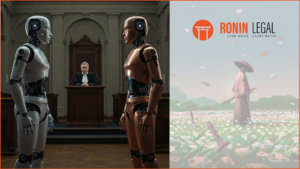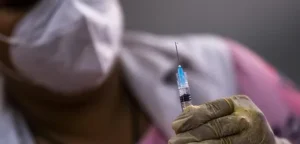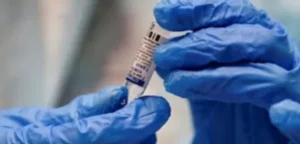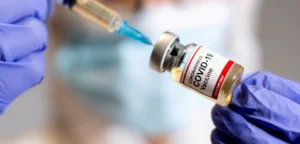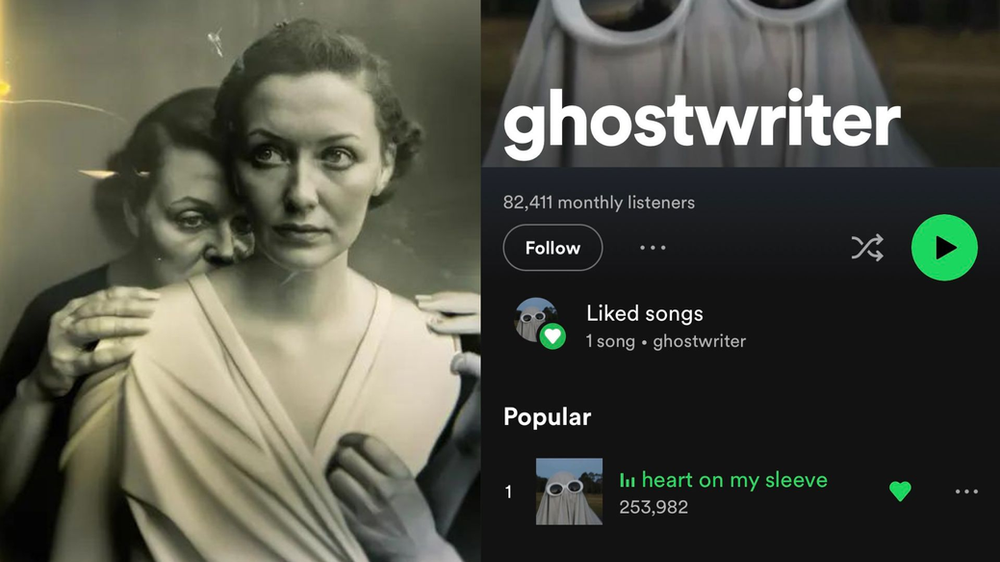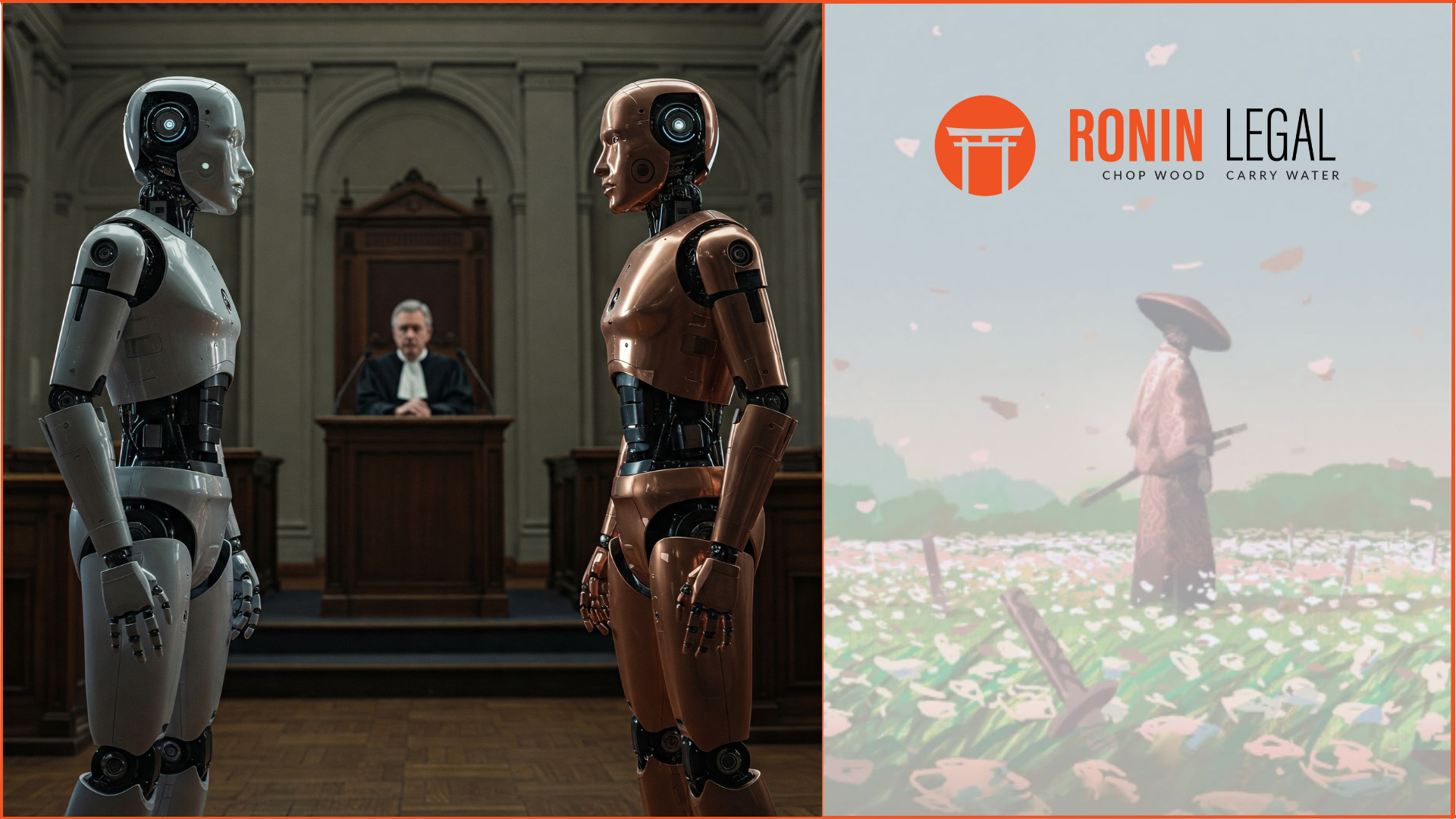By Shantanu Mukherjee and Anushka Iyer
BACKGROUND
LLMs such as ChatGPT, have demonstrated AI’s ability to generate various types of content based on text inputs, that resemble those created by humans – to the extent that it has become very difficult to differentiate between the two.
Recently, German artist Boris Eldagsen, whose entry won a prize at the Sony world photography awards, refused to accept the award, and later revealed that the photograph was generated using an AI tool.[1]
A song called “Heart on my Sleeve” featuring the voices of musicians Drake and The Weeknd received over 20 million views across streaming platforms, before abruptly disappearing (or rather being taken down) from these platforms, as it was generated using AI.[2]
In a recent letter, the record label Universal Music Group (UMG), instructed streaming platforms such as Spotify, and Apple, to prevent scraping of music from its platforms[3] which are subsequently used to train LLMs, giving rise to issues surrounding IP infringement, and loss of revenue to artists.
We’re now living in a world where algorithmic tools can generate artistic work or inventions indistinguishable from human work product, at scale, and instantly. That throws up all kinds of prickly legal questions:
Who owns AI-generated content? Should AI-generated content be eligible for IP protection? Can AI be regarded as having independently generated original work or should we view it as a mere tool for human creators, akin to a paintbrush? Can AI-generated content breach third-party rights, such as IP or publicity rights? Who’s liable?
We aim to answer and unpack some of these issues based on the current legal and regulatory environments in various jurisdictions – including the US, UK, EU, India, and Japan in our two-part series on AI & Ownership.
IP AND OWNERSHIP IN AI-GENERATED WORKS
An AI-powered product or tool itself, as the result of independent human labour, judgement, and creativity, may be eligible for IP protection: e.g., Tesla’s patented vehicular machine-learning (ML) system,[4] AI-powered toothbrushes that use recorded data to identify and suggest the correct ways to brush,[5] or IBM’s predictive software to determine employee flight risk with 95% accuracy.[6]
However, the legal position on IP protection for AI-generated works is rather the opposite. There is no legislation that addresses the issue but courts around the world have generally held that an AI cannot be an inventor or creator as it is not a natural person.
Notably, computer programs or software cannot be patented in India unless it forms a part of novel hardware. The Intellectual Property Offices of both UK and EU, have, in addition to the general requirements of patentability i.e. novelty, usefulness, and non-obviousness, prescribed a fourth requirement which requires software to exhibit a ‘technical effect’. Although neither defines the meaning of technical effect, it is generally understood as i) industrial machinery, or electrical devices in relation to physical objects; and ii) in relation to computers, it refers to computer hardware, security authentication, or output improvement. This is a non-exhaustive list, and the ‘technical effect’ is subject to the unique facts of each case.
JUDICIAL INTERPRETATIONS; LEGAL AND REGULATORY DEVELOPMENTS
1. Patents
On August 5, 2022, the U.S. Court of Appeals, in Thaler v. Vidal,[7] while determining whether anyone other than a human being can be considered an inventor, ruled that an AI system cannot be the ‘inventor’ of a patent. The patent applications were filed on behalf of DABUS (Device for the Autonomous Bootstrapping of Unified Sentience), a type of “connectionist AI system” developed by Thaler, which developed the inventions in question. While examining the case, the Federal Court focused on the statutory interpretation of the word ‘inventor’ under the U.S. Patent Act and held that only a “natural person” i.e. a human being could be considered as an inventor. On 24 April 2023, the U.S. Supreme Court declined a certiorari petition filed by Thaler, thus upholding the ruling of the U.S. Court of Appeals that only a human being could be an inventor in a patent application, and cementing the legal position on patent ownership by AI in the U.S.
However, immediately after, on 25 April 2023, the USPTO began a two-day consultation process on AI inventorship, which seeks public input on eleven issues, including the difference between the use of AI and other technical tools in the invention process, patentability of AI inventions under the current patent law framework surrounding joint ownership, and statutory or regulatory changes to effectively address the contributions made by AI to inventions hinting at a potential shift from the current approach adopted by the U.S.
The European Patent Convention (EPC) leaves the determination of the definition of ‘inventorship’ open for national legislation, however, similar to the rulings made by the courts in the U.S., it requires that an inventor in a patent application must be a human being, and not a machine.[8] Although no similar case has occurred in India yet, the Indian Patent Act states that a patent application may only be filed by a ‘person’[9] hinting that India may follow in the footsteps of the U.S. and Europe on this matter.
The EPC and the ruling by the U.S. Federal Court is an addition to the growing body of similar decisions around the world such as in the U.K., Europe, Australia, and Germany which have denied the grant of a patent to DABUS. The German Federal Patent Court, however, recognized that an AI system may contribute to works created by humans, and stated that it may consider an application that recognizes Thaler as the inventor, while noting the contributions made by DABUS.[10]
The only exception to the general view that AI cannot hold IP appears to be in South Africa, where the patent office issued a patent in July 2021, designating DABUS as the inventor and the machine’s owner (Stephen Thaler) as the patent owner. However, South Africa does not formally examine patent applications, and only requires applicants to complete a filing for their invention, so the patent appears to have simply been granted in the name of the inventor and the owner named in the filing, without further legal examination into the inventor’s legal capacity. The same patent has already been rejected in the UK, the US, and the EPO.
2. Copyrights
Copyright law protects any kind of work created by an individual including literary, visual, musical, etc. – provided that such work is original. We now know that AI is incapable of making something out of nothing i.e. all works generated using AI are in reference to the data on which it was trained, meaning that such works cannot be considered original.
Creative works are generally protected by copyright law if they are original – with most definitions of originality involving a human author.
UNITED STATES
The Copyright Office in the U.S. rejected copyright protection for the painting ‘A Recent Entrance to Paradise’ generated using Stephen Thaler’s AI system.
Shortly after, and in contrast to the above, in September 2022, the U.S. Copyright Office allowed copyright registration of a comic book “Zarya” (now revoked) which was developed with the help of a text-to-image AI tool. In October 2022, however, the U.S. Copyright Office sent another letter to the applicant of the copyright application stating that its registration may be cancelled. Finally, on February 21, 2023, the U.S. Copyright Office revoked the registration of Zarya stating that the works are not original, and instead a result of “mere mechanical process that operates randomly or automatically without any creative input from a human author”.[11]
US Copyright Registration Guidance for works generated using AI
On March 15, 2023, the U.S. Copyright Office (USCO) announced the first-ever formal guidance specifically aimed at governing copyright registration of works containing AI-generated material.
USCO clarified that AI-generated works devoid of human intervention or involvement will not be granted copyright protection as the “traditional elements of authorship”, in such cases, are generated by the AI and not the human user. Where sufficient human involvement can be established for e.g., where the human selects, arranges, or modifies AI-generated material in a creative manner, or if such work “reflects the author’s own mental conception”, the USCO may, on a case-by-case basis allow copyright protection for such works. USCO also requires copyright applicants to disclose when their work includes any AI-generated material, and previously filed applications must be amended to reflect the same.
The above reflects USCO’s willingness to grant AI-assisted works (as opposed to AI-generated works) copyright protection.
Other jurisdictions
Most jurisdictions, including Spain, Germany[12], India[13], Singapore[14], and Japa
[15] (either by way of statutes or judicial pronouncements) require that only works created by a human can be protected by copyright.
However, recently, the Copyright Office in India granted copyright protection to “Suryast”, a painting generated with the assistance of AI, when it was named as the ‘co-creator’ on the application, meaning that sufficient human input is required for any work to qualify for copyright protection. Similar to the U.S., this may reflect India’s willingness to grant copyright protection to AI-assisted works.
UNITED KINGDOM
Unlike the U.S., EU, and most other countries, the UK specifically recognizes copyright protection of works generated using a computer, where there is no human author involved.[16] However, emerging AI-generated works are qualitatively different from traditional computer-generated works, for they do not rely on creative human input.[17] Notably, UK’s Copyright, Designs and Patents Act (CDPA) was enacted in 1988, and in light of the drastic technological advancements, it may be outdated.
On 28 June 2022, the UK Intellectual Property Office published its response to a public consultation which reconsidered the copyright protection afforded to CGWs, among other issues on the interplay between AI and IP such as exceptions to copyright protection for TDM (which we will discuss in detail in Part 2), and patent protection for AI-generated inventions. The UK IPO decided to make no changes to the existing law and noted in its response that the use of AI was still in its early stages, and any premature modifications could result in unintended consequences. For now, it seems that UK has adopted the “wait-and-see” approach.
Can the prompt used to generate the work be protected under copyright?
While it is settled that an AI-generated work itself may not be subject to copyright protection, can the author of the prompt used to generate the work claim copyright on such prompts?
A prompt can be comparable to an idea. As per the well-settled principle of the idea-expression dichotomy, only the original expression of an idea can be protected and not the idea itself.[18] Hence, it appears that no copyright can be claimed over the prompt used to generate the work either.
CONCLUSION
Historically, intellectual property envisaged the need to adopt a human-centric approach to protect human intellectual creations and promote innovation. However, with rapid technological advancement, the standards of innovation have broadened to include those developed by or with the assistance of technology. In this regard, USCO’s guidance on the registration of AI-generated works is the first step towards recognizing that the current global IP framework needs modification to meet to changing requirements of a tech-centric world.
In Part 2 of our series on AI and ownership, we delve into the practice of text and data mining, and its implications on fair use, the right to publicity, and competition law.
REFERENCES
[1] Jamie Grierson, Photographer admits prize-winning image was AI-generate, The Guardian, April 17, 2023, https://www.theguardian.com/technology/2023/apr/17/photographer-admits-prize-winning-image-was-ai-generated.
[2] Anita Singh, Listen: AI-generated Drake and Weeknd song streamed 20 million times causes music industry alarm, The Telegraph, April 17, 2023, https://www.telegraph.co.uk/world-news/2023/04/17/drake-weeknd-ai-generated-song-heart-on-my-sleeve/.
[3] Dr. Hayleigh Bosher, Inside the music industry’s battle with the UK government over AI song generators, Brunel University London, April 14, 2023, https://www.brunel.ac.uk/news-and-events/news/articles/Inside-the-music-industry%27s-battle-with-the-UK-government-over-AI-song-generators.
[4]https://patents.google.com/patent/US10997461B2/en.
[5]https://patents.justia.com/patent/20220354625.
[6]https://www.cnbc.com/2019/04/03/ibm-ai-can-predict-with-95-percent-accuracy-which-employees-will-quit.html.
[7] Thaler v. Vidal, No. 2021-2347 (Fed. Cir. 2022).
[8] Article 19 and Rule 19(1) of the European Patent Commission.
[9] Section 6, Indian Patent Act, 1970.
[10] Christina Schulze, German Federal Patent Court points to solution for Dabus inventions, Juve Patent, November 16, 2021, https://www.juve-patent.com/cases/german-federal-patent-court-points-to-solution-for-dabus-inventions/.
[11] Stephen Wolfson, Zarya of the Dawn: US Copyright affirms limits on copyright of AI outputs, Creative Commons, February 27, 2023,n https://creativecommons.org/2023/02/27/zarya-of-the-dawn-us-copyright-office-affirms-limits-on-copyright-of-ai-outputs/.
[12]https://www.infolaw.co.uk/newsletter/2022/09/the-copyright-status-of-ai-generated-works/.
[13]https://www.lakshmisri.com/insights/articles/copyright-authorship-to-artificial-intelligence-who-owns-it/#.
[14]https://www.twobirds.com/en/insights/2022/singapore/copyright-protection-for-ai-generated-works-in-singapore.
[15] Tatsuhiro UENO, Copyright Issues on Artificial Intelligence and Machine Learning, http://www.f.waseda.jp/uenot/Copyright-AI-IJCAI2017.pdf.
[16]https://www.gov.uk/government/consultations/artificial-intelligence-and-ip-copyright-and-patents/artificial-intelligence-and-intellectual-property-copyright-and-patents.
[17] Jyh-An Lee, ’Computer-generated Works under the CDPA 1988′ in Jyh-An Lee, Reto Hilty, and Kung-Chung Liu (eds), Artificial Intelligence and Intellectual Property (Oxford Academic 2021) 178.





